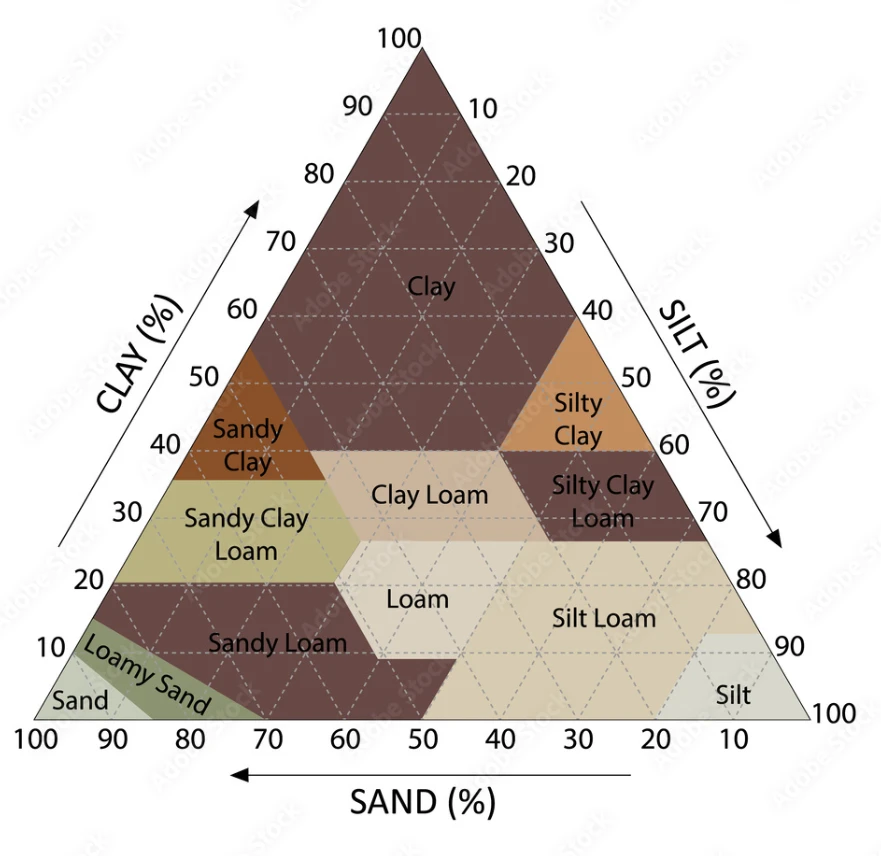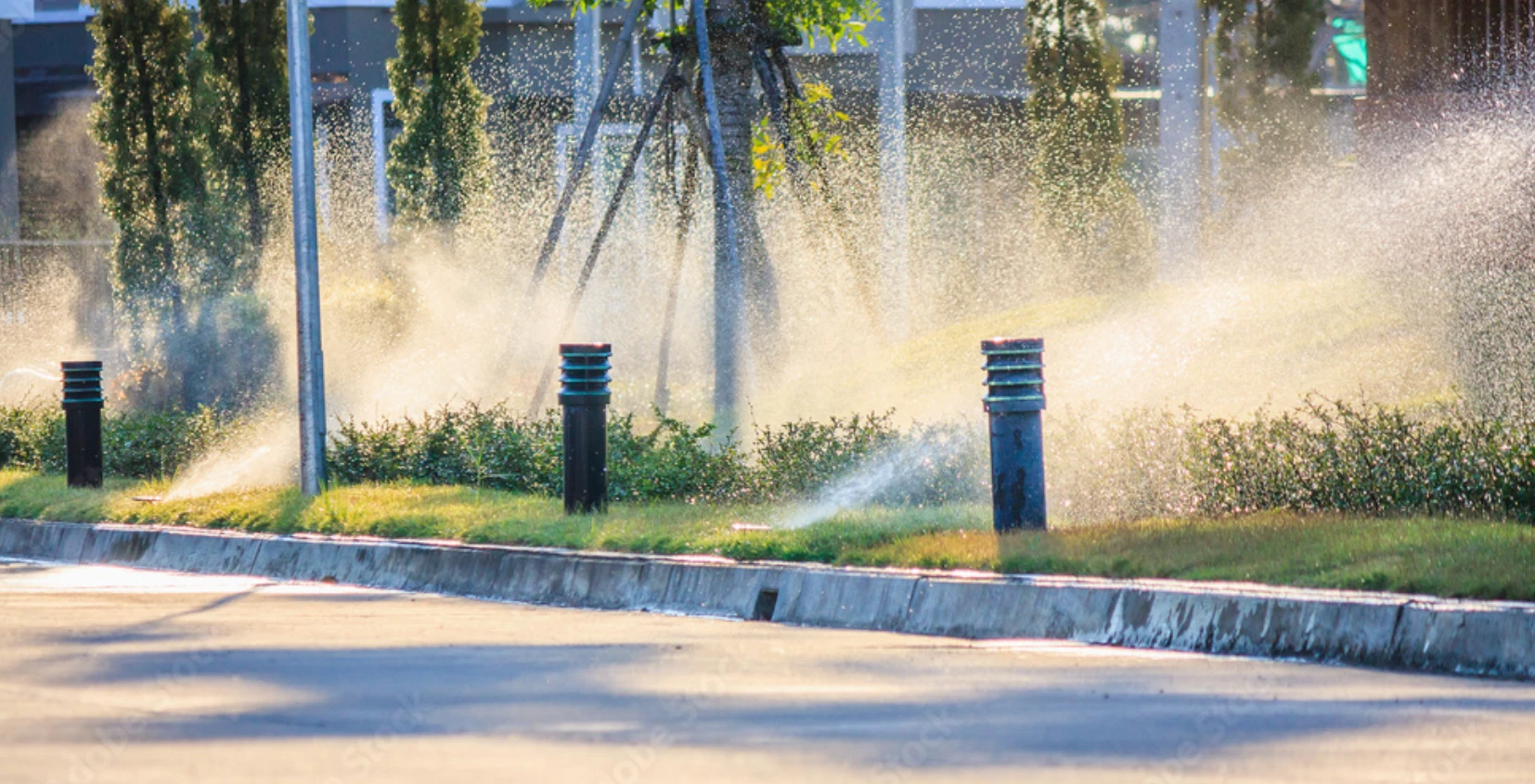Every Drop Counts
Water in the Soil
A proper irrigation system should aim to provide soil moisture that is at least equal to the readily available water in the soil, which is the amount of water that plants can easily uptake for growth.
Excessive amounts of water in the soil, as well as insufficient water in dry areas, can hinder plant growth and reduce soil fertility.
The amount of readily available water in the soil depends on various factors, including the texture and organic composition of the soil, which can affect the soil''s absorbency, as well as the active depth of the plant''s root system.
Proper irrigation and watering practices can help to optimize soil moisture levels and support healthy plant growth, leading to better crop yields and improved soil fertility.

Soil classification
The quality of the soil is characterized by the percentage (%) content of the sample in sand, silt and clay.
There are 12 types of soils:

Radical Depth
The active depth of a plant''s root system refers to the range of soil depths in which the roots are actively growing and absorbing water. The greater the active depth of the root system, the deeper the plant can absorb water and the more water it can access for growth. However, the permissible depletion of water in the rhizosphere (the soil immediately surrounding the roots), between two successive irrigations varies depending on the crop. For example, for depths ranging from 0-10 cm, the permissible depletion of water may be around 32%, while for depths ranging from 40-50 cm, it may be around 11%.
Proper irrigation and watering practices that take into account the active root depth and water needs of the specific crop can help to optimize soil moisture levels and support healthy plant growth.
Amount of Moisture in the soil
The water capacity of soil is the amount of water that the soil can hold and make available for watering plants, while the point of permanent wilting is the point at which the moisture in the soil is so low that the roots are unable to absorb it.
Soil moisture above the permanent wilting point and up to the water capacity is considered as available moisture, which is essential for plant growth. However, irrigation should not be allowed beyond the water capacity point, as the presence of excessive amounts of water in the soil can hinder plant growth.
The ratio of water capacity to permanent wilting point varies based on soil texture and other parameters, but for practical purposes, these values are typically considered constant for a particular soil.
Proper irrigation and watering practices that take into account the water capacity and permanent wilting point of the specific soil can help to optimize soil moisture levels and support healthy plant growth.
Infiltration capacity of the soil
The soil''s infiltrative capacity refers to the ability of the soil to infiltrate water at the surface or at depth. It is an important factor to consider when selecting the intensity at which irrigation water is applied to the soil, as well as to avoid water loss through surface runoff and soil compaction.
One method for measuring soil infiltrative capacity is the double ring infiltrometer method, which involves inserting two rings of different diameters into a water-filled tank and then into a soil sample. The time it takes for the water to infiltrate the soil is used to calculate the soil''s infiltrative capacity.
However, if on-site measurements are not possible, the soil''s infiltrative capacity can also be estimated based on its type and physical characteristics, such as texture, structure, and organic matter content. The soil''s infiltrative capacity can also be affected by factors such as previous land use, tillage practices, and the presence of surface seals or compaction layers. Understanding the soil''s infiltrative capacity can help with irrigation planning and management, as well as with the design and implementation of conservation practices to minimize water loss and improve soil health.

Infiltration capacity of the soil
The soil''s infiltrative capacity refers to the ability of the soil to infiltrate water at the surface or at depth. It is an important factor to consider when selecting the intensity at which irrigation water is applied to the soil, as well as to avoid water loss through surface runoff and soil compaction.
One method for measuring soil infiltrative capacity is the double ring infiltrometer method, which involves inserting two rings of different diameters into a water-filled tank and then into a soil sample. The time it takes for the water to infiltrate the soil is used to calculate the soil''s infiltrative capacity.
However, if on-site measurements are not possible, the soil''s infiltrative capacity can also be estimated based on its type and physical characteristics, such as texture, structure, and organic matter content. The soil''s infiltrative capacity can also be affected by factors such as previous land use, tillage practices, and the presence of surface seals or compaction layers. Understanding the soil''s infiltrative capacity can help with irrigation planning and management, as well as with the design and implementation of conservation practices to minimize water loss and improve soil health.

Water saving improves plant health and increases production.
Water conservation, plant health improvement, and increased production are key goals in modern agriculture. One way to achieve these objectives is through proper irrigation management, which involves using the rate of soil water extraction as a tool to optimize irrigation of the field.
The permissible extraction of water in the root zone, which is the area between two consecutive irrigation events, is an important factor to consider when aiming for maximum production. It is dependent on the specific crop being cultivated and can be influenced by factors such as soil type, climate, and irrigation method.
To ensure optimal irrigation and minimize water use, it is necessary to continuously monitor soil moisture levels in the root zone. This can be done using sensors that measure soil moisture content and transmit the data to an irrigation control system. By processing this information in relation to atmospheric humidity and other relevant parameters, it is possible to automate irrigation decisions and only apply water when it is needed, helping to conserve water and improve plant health.
Customizable
- Soil type
- Ground slope
- Basic soil permeability
- Exposure to light
- Plant requirements / plant type
- Active root system depth
- Zoning
- Placement of sprinklers
- Sprinkler type
- Sprinkler pressure
- Soil type
- Ground slope
- Basic soil permeability
- Exposure to light
- Plant requirements / plant type
- Active root system depth
- Zoning
- Placement of sprinklers
- Sprinkler type
- Sprinkler pressure
Save up to 50% water consumption and increase production
This product help save up to 50% of water consumption and increase production through effective irrigation management. It is easy to use and configure, and can be integrated into any existing irrigation system without the need to modify the current infrastructure or install an automatic watering system.
All that is required is the presence of an electric valve in each watering zone, and the central controller will open and close the supply to each solenoid valve as needed based on the watering needs of the specific zone. This helps to ensure that water is applied efficiently and only when needed, helping to conserve resources and improve plant health and production.




